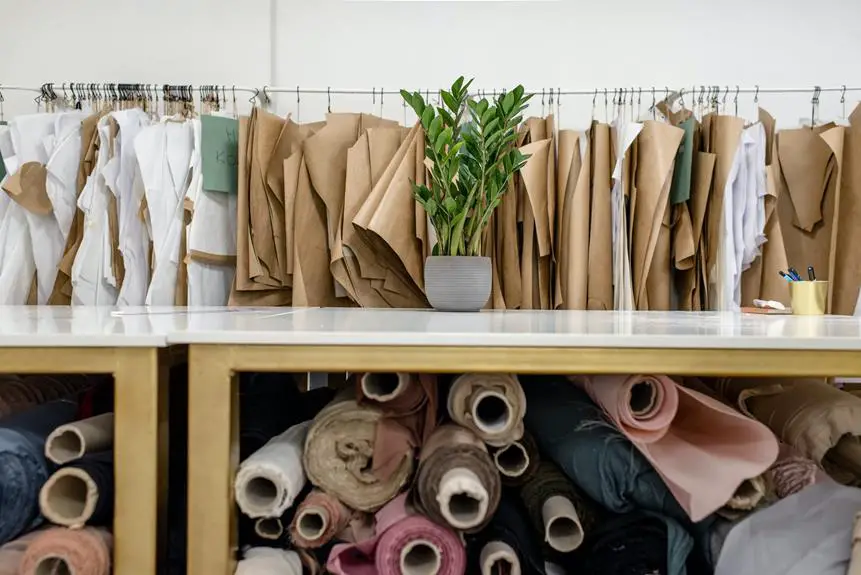Wondering if E6000 glue can be used on fabric?
You'll be pleased to know that this versatile adhesive can indeed bond effectively with various types of fabric. Understanding the proper techniques for using E6000 glue on fabric will ensure that your projects are successful and long-lasting.
From preparation to application, mastering the process will allow you to confidently tackle fabric-related endeavors with this adhesive.
So, let's explore the intricacies of using E6000 glue on fabric and unlock the potential for your crafting and DIY projects.
Key Takeaways
- The chemical composition of E6000 glue allows it to bond effectively with fabric fibers.
- Fabric compatibility testing is important to assess whether E6000 glue adheres well to a specific type of fabric.
- Properly preparing the fabric surface, such as washing and ironing, is crucial for a strong bond with E6000 glue.
- Different fabric bonding techniques, such as stitching, iron-on adhesive, fusible interfacing, fabric glue, and fabric tape, can be used with E6000 glue for fabric projects.
Understanding E6000 Glue Composition
You need to understand the composition of E6000 glue to determine its suitability for use on fabric.
E6000 glue is a popular choice for various adhesive applications, including fabric. Its adhesion properties and chemical composition play a crucial role in its effectiveness on fabric. The key to its success lies in its flexibility and strength, which are essential for adhering to different types of fabric.
The chemical composition of E6000 glue includes a unique formula that allows it to bond effectively with fabric fibers. This composition gives it the ability to withstand the stresses and strains that fabrics often endure, making it a reliable choice for fabric adhesion.
When using E6000 glue on fabric, it's important to take safety precautions. Ensure proper ventilation, as the glue emits strong fumes. Additionally, use the glue in a well-ventilated area and avoid inhaling the fumes. It's also advisable to wear gloves to protect your skin from direct contact with the adhesive.
Understanding the composition of E6000 glue gives you insight into its fabric adhesive applications and helps you take the necessary safety precautions when using it.
Fabric Compatibility Testing
Understanding the composition of E6000 glue gives us insight into its fabric adhesive applications and helps us take the necessary safety precautions when using it. To determine its effectiveness on fabric, you can conduct fabric compatibility testing. Fabric adhesion and glue compatibility are crucial factors to consider when using E6000 on fabric. Conducting fabric compatibility testing allows you to assess whether the glue adheres well to the specific type of fabric you intend to use it on. It involves applying a small amount of E6000 glue to a sample of the fabric and allowing it to cure according to the manufacturer's instructions. After the curing process, you can test the bond strength and flexibility of the glue on the fabric sample to determine its compatibility. The table below provides an example of how you can conduct fabric compatibility testing for E6000 glue on different types of fabric.
| Fabric Type | Adhesion Result | Compatibility |
|---|---|---|
| Cotton | Strong | Compatible |
| Polyester | Moderate | Compatible |
| Silk | Weak | Incompatible |
Preparing Fabric for Gluing
Before applying E6000 glue to fabric, it's important to prepare the fabric surface properly to ensure a strong bond.
You should consider the type of fabric and whether it needs any treatment, such as washing or ironing, before gluing.
Additionally, choosing the right adhesive for your specific fabric type and conducting a test for adhesion strength are crucial steps in preparing fabric for gluing.
Fabric Surface Treatment
To ensure proper adhesion of E6000 glue to fabric, it's important to thoroughly clean the fabric surface. Here are four essential steps for preparing the fabric for gluing:
- Pre-wash the Fabric: Remove any dirt, oils, or finishes that may hinder the adhesive bond.
- Iron the Fabric: Smooth out wrinkles and creases to create a flat, even surface for gluing.
- Avoid Fabric Softeners: These can leave a residue that interferes with the adhesive bond.
- Use Rubbing Alcohol: Wipe the fabric with rubbing alcohol to further clean and degrease the surface.
Following these steps will help optimize the fabric's surface for bonding with E6000 glue, ensuring a secure and durable adhesive bond.
Choosing Suitable Adhesives
First, thoroughly clean the fabric surface to ensure proper adhesion of E6000 glue. When choosing suitable adhesives for fabric, it's essential to consider the type of fabric, the intended use of the bonded materials, and the durability required. Here's a simple guide to help you select the right adhesive for your fabric:
| Type of Fabric | Recommended Adhesive |
|---|---|
| Cotton | Fabric glue, spray adhesive |
| Denim | Heavy-duty fabric glue, epoxy |
| Silk | Fabric glue, clear-drying adhesive |
Before applying any adhesive, conduct fabric adhesion testing on a small, inconspicuous area to ensure compatibility and adhesion strength. This simple step can save you time and effort while ensuring a strong and lasting bond between the fabric and the adhesive.
Testing Adhesion Strength
To test the adhesion strength and prepare the fabric for gluing, first, thoroughly clean the fabric surface to ensure proper adhesion of E6000 glue.
Here's how to conduct adhesion testing and prepare the fabric for gluing:
- Surface Preparation: Remove any dirt, dust, or residue from the fabric using a mild detergent and water. Ensure the fabric is completely dry before proceeding.
- Compatibility Check: Test a small area of the fabric with E6000 glue to ensure it adheres well without causing any discoloration or damage.
- Roughening the Surface: For smooth fabrics, lightly sand the surface to create a slightly rough texture, promoting better adhesion.
- Avoiding Excess Glue: Apply a thin, even layer of E6000 glue to the fabric, avoiding excessive application that may lead to poor adhesion or seepage.
Applying E6000 Glue to Fabric
When applying E6000 glue to fabric, ensure that the surface is clean and free from any dirt or debris. This is crucial for the adhesive to bond effectively.
Different gluing techniques can be used, such as applying the E6000 glue directly onto the fabric or using a small brush to spread the glue evenly. Consider the fabric compatibility and the type of material you're working with to ensure the best results.
Additionally, prepare the fabric by gently cleaning it and allowing it to dry before applying the glue. It's important to note that E6000 offers a strong adhesive option for fabric, but there are other adhesive options available as well. However, E6000 is known for its durability and flexibility, making it an excellent choice for fabric projects.
Bonding Techniques for Fabric Projects
Ensure that the fabric and the item you're bonding it to are clean and free from debris before applying the E6000 glue to achieve a strong and long-lasting bond. When working on fabric projects, it's important to consider the bonding techniques for the best results. Here are some methods and alternatives for bonding fabric using E6000 glue:
- Clamping: After applying the E6000 glue to the fabric and the item, use clamps to hold them together tightly. This ensures even pressure for a secure bond.
- Double-Sided Tape: For delicate fabrics, applying double-sided tape to the item before adding the E6000 glue can provide extra support and prevent the glue from seeping through the fabric.
- Topstitching: In addition to E6000 glue, consider reinforcing the bond by sewing around the edges of the fabric and the item. This technique provides added strength and stability.
- Fabric Adhesive: If E6000 glue isn't available, consider using fabric adhesive specifically designed for bonding fabric to various items. It offers a reliable alternative for fabric bonding projects.
Curing and Drying Process
Once you've applied E6000 glue to your fabric project, it's important to allow for sufficient drying time. This ensures that the adhesive cures properly for maximum adhesion.
Make sure to provide proper ventilation during the curing process to help the glue set effectively.
Fabric Drying Time
To achieve optimal adhesion when using E6000 glue on fabric, it's important to understand the fabric drying time and the curing process. Here are some essential points to consider:
- Patience is Key: Allow the glued fabric to dry for at least 24 to 72 hours for maximum adhesion.
- Proper Ventilation: Ensure the glued fabric is placed in a well-ventilated area to aid in the drying process.
- Avoid Disturbance: Refrain from moving or manipulating the fabric during the drying period to prevent disruption of the adhesion process.
- Consider Temperature and Humidity: Adjust the drying time based on temperature and humidity levels to ensure the fabric cures properly.
Understanding and implementing these fabric drying techniques will contribute to the overall success of your fabric adhesion project.
Curing for Adhesion
For optimal adhesion when using E6000 glue on fabric, it's essential to focus on the curing process, allowing the glue to fully set and bond with the fabric. After applying the E6000 glue to the fabric, it's important to allow it to cure for at least 24 to 72 hours for maximum adhesion.
During this curing time, it's crucial to ensure that the fabric and glue are held together firmly, using clamps or heavy objects if necessary, to promote strong adhesion. Once the curing process is complete, perform adhesion testing to ensure that the bond is secure.
Additionally, consider using fabric adhesion techniques such as roughening the fabric surface slightly to enhance the bond with the E6000 glue. By paying attention to the curing process and employing effective fabric adhesion techniques, you can maximize the adhesion of E6000 glue on fabric.
Proper Ventilation During Curing
During the curing process, ensure that you allow proper ventilation for the fabric and E6000 glue to dry thoroughly. Here are some important ventilation safety precautions to keep in mind:
- Outdoor Drying: If possible, choose a well-ventilated outdoor area for the curing process to prevent inhaling fumes.
- Use a Fan: Place a fan in the room to improve air circulation and aid in the drying process.
- Open Windows and Doors: Ensure that windows and doors are open to allow fresh air to flow through the space.
- Avoid Enclosed Spaces: Refrain from drying the fabric and glue in enclosed spaces to prevent the buildup of fumes.
When using E6000 glue, these ventilation safety measures are crucial for your well-being. Additionally, consider exploring alternative fabric glues if ventilation options are limited.
Considerations for Washability and Durability
If you plan to wash or wear the fabric frequently, consider the durability and washability of E6000 glue when using it for fabric projects. E6000 glue is known for its strong bond, but it's essential to assess its washability and durability for fabric applications. When using E6000 glue on fabric, it's important to consider how the fabric will hold up to washing and regular wear. To help you make an informed decision, here are some considerations for washability and durability:
| Washability Considerations | Fabric Durability Testing |
|---|---|
| Check the label for washability instructions. Some fabrics may not be suitable for washing after applying E6000 glue. | Perform a fabric durability test by applying E6000 glue to a small, inconspicuous area of the fabric and subjecting it to simulated wear and washing. |
| Consider hand washing or using a gentle cycle when laundering fabric items with E6000 glue to prolong their lifespan. | Observe how the fabric holds up to the simulated wear and washing to determine its durability when treated with E6000 glue. |
| Avoid exposing fabric items with E6000 glue to harsh chemicals or high heat during washing to maintain the bond and fabric integrity. | Assess the fabric's strength, colorfastness, and overall condition after the durability testing to gauge the impact of E6000 glue on washability and durability. |
Considering these factors can help you determine if E6000 glue is suitable for your fabric project and ensure that your creations remain durable and washable.
Troubleshooting Common Issues
Experiencing difficulty with E6000 glue on fabric? Here are some troubleshooting tips to help you overcome common issues:
- Surface Preparation: Ensure that the fabric surface is clean and free from any dirt, oils, or residue. Use rubbing alcohol to clean the area before applying the glue.
- Proper Application: Apply the E6000 glue evenly and sparingly to avoid excess glue that could hinder adhesion. Use a small amount and spread it thinly for better results.
- Clamping or Pressure: After applying the glue, use clamps or apply pressure to the bonded surfaces. This helps in creating a strong bond between the fabric and the glue.
- Curing Time: Allow the E6000 glue to cure for the recommended time before handling the fabric. Proper curing time ensures that the bond is strong and durable.
Remember to follow these troubleshooting tips to address any adhesion issues when using E6000 glue on fabric. Additionally, consider exploring different fabric bonding methods to find the most suitable technique for your specific project.
Frequently Asked Questions
Can E6000 Glue Be Used to Attach Fabric to Non-Fabric Surfaces?
Yes, E6000 glue can effectively bond fabric to non-fabric surfaces, making it a versatile choice for DIY projects. It provides strong and durable adhesion, ensuring your fabric stays securely in place.
Is E6000 Glue Safe to Use on Children's Clothing or Items That Come Into Contact With Skin?
When using E6000 glue on children's clothing or skin-contact items, take precautions for safety. Avoid direct skin contact with the glue, and ensure proper ventilation during use. Follow fabric bonding techniques carefully to maintain safety and durability.
Will E6000 Glue Hold up to Extreme Temperatures, Such as Those Experienced in Outdoor Fabric Projects?
Yes, E6000 glue is versatile and can withstand extreme temperatures for outdoor durability. It adheres well to non-fabric surfaces, making it suitable for various projects. Its strong adhesion makes it a reliable choice for your needs.
Can E6000 Glue Be Used to Repair Tears or Holes in Fabric, or Is It Only Suitable for Bonding Larger Pieces Together?
Yes, E6000 glue can effectively repair tears and holes in fabric due to its strong adhesion. It's not limited to bonding larger pieces; it can also handle smaller repairs with great effectiveness.
Are There Any Special Considerations or Precautions to Take When Using E6000 Glue on Delicate or Sheer Fabrics?
When bonding delicate or sheer fabrics with E6000 glue, take precautions. Consider the fabric's sensitivity, potential skin contact safety, and extreme temperatures. Use with care for outdoor fabric projects and repairs on children's clothing.
- Tetron Fabric for Marine Applications: Durability and Use Cases - June 18, 2025
- Tetron Fabric for Outdoor Furniture: Weather Resistance and Care - June 18, 2025
- Tetron Fabric for Wall Coverings: Style and Application Tips - June 18, 2025







